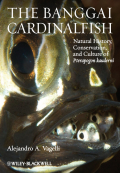
The Banggai cardinalfish: natural history, conservation, and culture of Pterapogon kauderni
Vagelli, Alejandro A.
The Banggai cardinalfish, Pterapogon kauderni, is a fascinating species that possesses a series of remarkable biological characteristics making it unique among coral reef fishes. It has been the focus of studies in reproduction, ecology, population genetics and evolution. In addition, since its rediscovery in the late 1990s, it has become tremendously popular in the international ornamental fish trade, and indiscriminate collecting has led to its inclusion in the2007 IUCN Red List as an endangered species. This book is divided into three main parts: a general introduction to the fish, including a historical synopsis with an overview of the Banggai Archipelago; a comprehensive treatment of the species natural history (distribution, morphology, reproduction, embryology,ecology, genetics, systematics and evolution); an account of the conservationof the species, including descriptions of its fishery, attempts to protect itunder CITES, and introduction programmes. The book also includes an appendix offering information on captive breeding, juvenile mortality reduction, and common diseases. This book is a unique resource for ichthyology students and researchers working on fish biology, ecology and conservation, and for marine ornamental fish hobbyists and aquarium professionals. INDICE: Preface x Acknowledgments xiii Part I Introduction 1 1 Introduction 3 1.1 The Banggai cardinalfish and a long rewarding experience 3 2 Historic Review 6 2.1 The improbable first encounter 6 2.2 Rediscovering the King of the Cardinalfishes, and a prophecy realized 8 2.3 Other field studies 9 3 The Banggai Archipelago 11 4 Field Research in the Banggai Islands 21 4.1 Introduction 21 4.2 A challenging first expedition 22 Part II Natural History 29 5 Geographic Distribution 31 5.1 Introduction 31 5.2 The geographic distribution of Pterapogon kauderni within its natural range 33 5.3 The Luwuk population 36 5.4The north Sulawesi populations 38 5.5 Other exotic populations 39 5.6 Discussion 40 6 General Survey of Morphology 46 6.1 Introduction and some particularsof the soft anatomy 46 6.2 Main osteological characteristics (Figure 6.2a, see Tables 6.1, 6.2 for selected body proportions and counts) 49 7 Reproductive Biology 58 7.1 General aspects of reproduction in Apogonidae 58 7.2 The reproductive biology of Pterapogon kauderni 75 8 Ecology 94 8.1 Main ecological aspects of Apogonidae 94 8.2 Habitat and microhabitat preference of Pterapogon kauderni 95 8.3 Common fish assemblages including Pterapogon kauderni 101 8.4 Group structure 102 8.5 Reproductive ecology 104 8.6 Trophic habits 109 8.7 Likely predators of Pterapogon kauderni 119 8.8 Natural occurrence of parasites in Pterapogon kauderni 120 9 Genetics 123 9.1 Introduction 123 9.2 Genetic structure in Pterapogon kauderni 124 9.3 Possible spot polymorphism 125 10 Systematics and Evolution 128 10.1 Introduction 128 10.2 Taxonomy of Pterapogon kauderni 130 10.3 Recent phylogenetic studies and intergeneric relationships of Pterapogon 131 10.4 Direct development and the Banggai-Australian connection: Couldontogeny and paleogeography provide hints about the origin and intergeneric relationships of Pterapogon? 132 10.5 Evolution of Apogonidae. The case for a freshwater-origin of the family 138 Part III Conservation 145 11 The Fishery ofPterapogon kauderni 147 11.1 Introduction: Pterapogon kauderni, a species particularly susceptible to high collection pressure 147 11.2 The history of the trade 149 11.3 Field surveys and a bleak conservation situation 150 11.4 The capture, handling and shipping of Pterapogon kauderni: high mortality explained152 12 Conservation of Pterapogon kauderni, a Challenge Still Ahead 158 12.1 The unsuccessful proposal for regulating the capture and trade of Pterapogon kauderni 158 12.2 The real significance of Pterapogon kauderni in the local economy. Why the livelihood of the Banggai people should not be used as an excuseto prevaricate the protection of this species 160 12.3 The potential benefitsof and resistance to regulate the capture and trade of Pterapogon kauderni 161 13 The Lembeh Conundrum, from a Careless Action to a Grave Conservation Situation 166 13.1 The Lembeh population and its impact in the Lembeh Strait 166 13.2 A word for the hobbyists 170 Part IV Appe
- ISBN: 978-0-470-65499-6
- Editorial: John Wiley & Sons
- Encuadernacion: Cartoné
- Páginas: 224
- Fecha Publicación: 19/08/2011
- Nº Volúmenes: 1
- Idioma: Inglés
